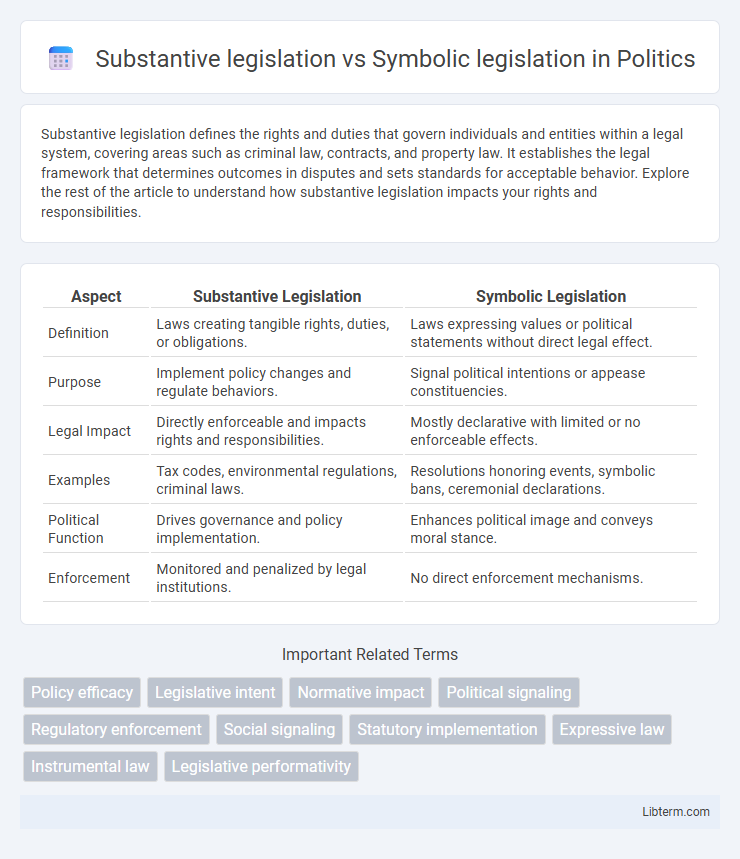Substantive legislation defines the rights and duties that govern individuals and entities within a legal system, covering areas such as criminal law, contracts, and property law. It establishes the legal framework that determines outcomes in disputes and sets standards for acceptable behavior. Explore the rest of the article to understand how substantive legislation impacts your rights and responsibilities.
Table of Comparison
| Aspect | Substantive Legislation | Symbolic Legislation |
|---|---|---|
| Definition | Laws creating tangible rights, duties, or obligations. | Laws expressing values or political statements without direct legal effect. |
| Purpose | Implement policy changes and regulate behaviors. | Signal political intentions or appease constituencies. |
| Legal Impact | Directly enforceable and impacts rights and responsibilities. | Mostly declarative with limited or no enforceable effects. |
| Examples | Tax codes, environmental regulations, criminal laws. | Resolutions honoring events, symbolic bans, ceremonial declarations. |
| Political Function | Drives governance and policy implementation. | Enhances political image and conveys moral stance. |
| Enforcement | Monitored and penalized by legal institutions. | No direct enforcement mechanisms. |
Understanding Substantive Legislation
Substantive legislation establishes actual rights, duties, and obligations that govern behavior and have direct legal consequences, distinguishing it from symbolic legislation, which primarily serves to convey political messages or express societal values without enforcing tangible legal effects. Understanding substantive legislation requires analyzing its enforceability through courts and its impact on individuals and institutions, ensuring laws create measurable regulation and protections. This type of legislation is fundamental in shaping legal frameworks that address specific issues such as criminal conduct, property rights, and contract enforcement.
Defining Symbolic Legislation
Symbolic legislation refers to laws enacted primarily to express societal values or political ideals without creating significant legal consequences or practical effects. Unlike substantive legislation, which establishes concrete rights, duties, or penalties, symbolic laws serve to communicate government intentions, reinforce norms, or signal policy priorities to the public. These laws often address moral or symbolic issues, aiming to shape public opinion or political identity rather than regulate behavior.
Key Differences Between Substantive and Symbolic Laws
Substantive legislation enacts concrete rules that define rights and duties, while symbolic legislation primarily expresses societal values or political statements without immediate practical effect. Key differences include the enforceability and direct impact of substantive laws compared to the largely declaratory nature of symbolic laws. Substantive laws influence behavior through clear legal obligations, whereas symbolic laws aim to communicate collective ideals or signal political positions.
The Purpose and Impact of Substantive Legislation
Substantive legislation establishes concrete laws that regulate behavior, rights, and obligations, creating enforceable rules with tangible social and legal consequences. Its purpose is to address specific issues directly, aiming to produce measurable changes in society and governance through effective implementation and compliance. The impact of substantive legislation is significant, fostering legal certainty, protecting individual rights, and promoting social order by providing clear standards for conduct and dispute resolution.
Motivations Behind Symbolic Legislation
Symbolic legislation primarily serves to express societal values, political ideals, or moral stances without necessarily creating enforceable legal rights or obligations. Motivations behind symbolic legislation often include signaling political commitment, appeasing public opinion, or shaping cultural norms rather than immediate regulatory impact. This type of legislation can influence public discourse and set the stage for future substantive legal reforms.
Examples of Substantive Legislation in Practice
Substantive legislation establishes concrete legal rights and obligations, often affecting social, economic, or political structures, such as the Civil Rights Act of 1964, which prohibited discrimination based on race, color, religion, sex, or national origin. Another example is the Clean Air Act, which imposes enforceable regulations to reduce air pollution and protect environmental quality. These laws create tangible outcomes and enforcement mechanisms, distinguishing them from symbolic legislation that primarily aims to express values or political stances without substantial regulatory impact.
Case Studies of Symbolic Legislation
Symbolic legislation refers to laws enacted primarily to convey a political message or express societal values rather than to produce significant legal effects, evident in cases like the 1996 U.S. Defense of Marriage Act, which symbolized opposition to same-sex marriage before being invalidated. Case studies demonstrate symbolic legislation's reliance on public sentiment, such as the U.K.'s Dangerous Dogs Act 1991, which, despite being widely criticized for lack of effectiveness, reinforced government responsiveness to social fears about dog attacks. These examples highlight how symbolic laws often function as tools for political signaling and cultural reflection rather than substantive legal change.
Public Perception and Political Implications
Substantive legislation directly addresses social problems and delivers tangible benefits, often improving public perception by demonstrating government responsiveness and efficacy. Symbolic legislation primarily serves to signal values or political stances without immediate practical effects, influencing public opinion by reinforcing identity and ideological alignment. Politically, substantive laws can bolster credibility and support through real-world impact, whereas symbolic laws may solidify a political base but risk criticism for superficiality or ineffectiveness.
Challenges in Drafting Effective Legislation
Drafting effective legislation faces challenges in balancing substantive legislation, which addresses concrete rights and duties, with symbolic legislation aimed at signaling values or intentions without enforceable measures. Substantive laws require precise language to ensure clarity and enforceability, while symbolic laws risk ambiguity that can undermine legal certainty and public trust. Legislators must carefully navigate political pressures, societal expectations, and legal frameworks to create statutes that are both meaningful and practically implementable.
The Future of Lawmaking: Balancing Substance and Symbolism
Substantive legislation addresses concrete policies and legal frameworks directly impacting societal issues, while symbolic legislation often serves to express values or political positions without immediate practical effect. The future of lawmaking demands a balanced integration of both approaches to ensure laws are effective yet reflective of collective ideals, fostering public trust and meaningful change. Advances in data analytics and public engagement platforms will enable lawmakers to craft statutes that blend substantive outcomes with symbolic resonance, adapting to evolving social dynamics.
Substantive legislation Infographic

 libterm.com
libterm.com